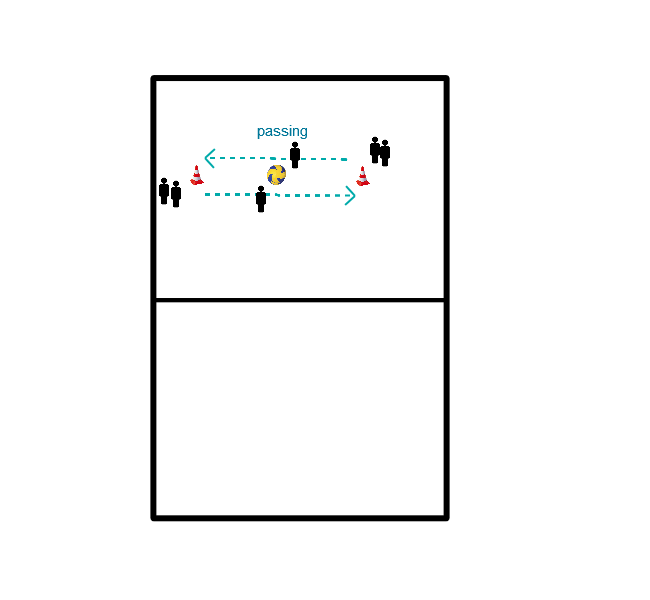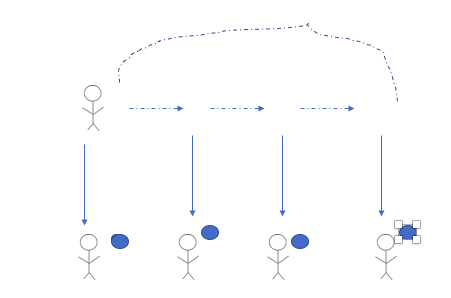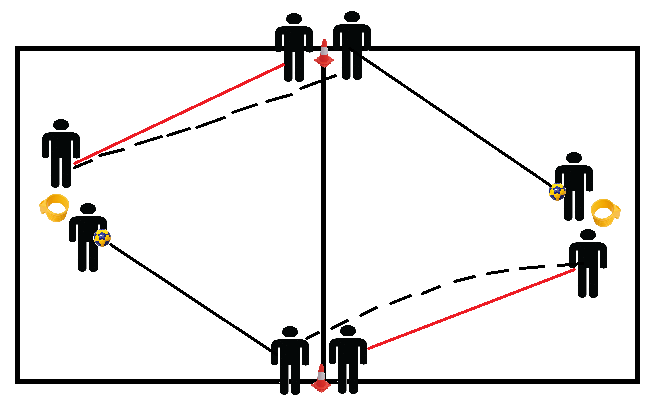Korfball drills
- Place two posts where they usually are during a game.
- Then place two pilons at the far left and far right on the center line.
- Ideally, this exercise is done with 8 people, more is possible, less than 8 doesn't work.
- At each post or pilon two people are standing, one person under the post starts with the ball (on both sides).
- This person throws the ball to someone near the pilon on his right and runs after the ball.
- This person then throws the ball to the other post, and the second person near the pilon goes for a through-ball.
- Now the ball is under the post again and the round starts over again.
Arrangement:
(Black line: throwing and running after the ball) (Black dotted line: throwing ball) (Red line is running for a through-ball)
- You put up four poles in a square,
- in the middle of the four poles you put down a pilon.
- four children will be passers at the poles and
- the rest of the children will stand by the pilon in the middle.
- First, you can choose that the attackers have to take through-balls at the poles.
- It doesn't matter which pole, they may run at the same pole a maximum of 2 times in a row.
- You can choose this, so they have to run a lot.
- The children also have to score twice, the person who does this first may definitely switch positions with a passer, the other may switch as well as soon as they score twice.
- After that you can choose to let the children do free balls, penalty throws, dodge-balls, etc.

- Put pilons about 6 meters apart. Divide the group into 2.
- In the case of five, one group of 3 and a group of two.
- The goal is to keep the ball in the middle between the pilons at all times.
- As soon as a player receives the ball, the player must be at the centre of the other side.
- After you have passed the ball, you join the back row on the opposite side.
- NB: Nobody stands still and tries to see what happens at all times
- Do not arrive too early or too late.
- Throwing while moving.
- After five minutes switch side (left hand).
- Make pairs, at each post a pair.
- We are now going to use the posts lengthwise, namely one player of the pair attacks the post opposite to him or her.
- One player of the opposite post does the same.
- How does this work?
- Of each pair there is a number 1 and a number 2.
- Number 1 is going to defend his post for a minute and a half against the other number 1 of the post opposite to him.
- When the number 1 of a post has had a chance, the other number will attack and so there will be a change of function (and of post, because everyone is defending his own post).
- So there is always a change of function if the attacker has lost the ball.
- As a player, you are attacking as well as defending for a minute and a half
At a distance of +/- 15 meters from each other, make two compartments with 4 pilons of 1.5 x 1.5 meters.
Make two teams with an equal number of players.
- Each team has its own compartment.
- The other team tries to conquer the other team's square.
- This happens when 1 striker is standing in the opponent's square and the ball is played by a team-mate.
- They get 1 point. No other players are allowed in the box.
- When the defence intercepts the ball, they may immediately start the attack on the opponent's square.
Variation:
- on time
- with points
- of both teams 1 player is allowed in the box
- no limit on the number of defendants in box
- no limit on the number of attackers in box
- customize size of box
- distance between boxes
- One ball per groups of two/three.
- The players pass until they reach a post.
- At the post both players may shoot once.
- Then they have to pass again to another post.
- All groups just cross each other.
- Whichever team to achieve 15 goals first wins(optional).
- 4 children are standing next to each other, about 5 meters apart.
- 1 child is going to do the exercise:
- Receives the ball at the first pilon, returns it to the player on the other side, and moves on to the second pilon and so on.
- At the back pilon he returns with a full sprint.
- Then switch, everyone moves a place, number 5 does the exercise now.
- Everybody has their turn. Possibly everyone could go 2-3x.

- Work in groups of 2-3 or 4 and a post.
- Players stand in front of each other and throw the ball to each other.
- Player A throws to player B.
- Player A runs towards player B, but then backs away towards the post and gets the ball from player B (deep pass).
- Player A shoots the ball into the post.
- Make sure you run close enough to the post.
- Don't stop running too early and the pass must be precise.
- You can extend the exercise further by passing the ball back to player B instead of taking a shot,
- then it's important that player B makes a running action to become available for a pass.
- Players stand in front of each other and each has a ball in one of their hands.
- One in their left hand, the other in their right hand.
- Now they are going to throw the balls to each other
- ...so for a certain period of time or for several times
- Player 1 throws the ball to the oncoming player 2 who is not running straight into the ball,
- but diagonally to the right of the player.
- Player 1 runs to the other side, receives the ball halfway from player 2 and throws it to the pilon he came from, player 4, and connects behind the other pilon where only player 3 is.
- Player 2 connects behind player 4.
- Player 1 must make a quarter turn to be able to throw the ball from player 2 to player 4, this turn must be done airborne.
- Arrange a square with a distance of about 10 meters.
- For larger groups, pentagons can be used.
- Player 1 throws the ball to player 2, runs after the ball and gets the ball back to player 2.
- Player 1 throws the ball to player 3, runs after the ball, receives and throws it to player 4.
- Arrivin at player 4, player 1 should throw a long diagonal ball to player 2 and player 1 can take up his original position.
- Player 2 continues the exercise.
- This exercise should be done twice each and then be done in the other direction.
- Who is first to finish the exercise?
- Watch out for uneven distances.
- Shooter stand in front of the post, with a defender
- Shooter stand in front of the post, with a defender
- The ball is thrown in from under the post, after which the ball is handled from the outer to the inner hand for a through-ball.
- The pilon is now placed 6 metres in front of the post, a passer with ball stands under the post.
- A runner and defender stand at the pilon.
- The runner goes back and forth around the pilon and starts counting how many times he or she can double the ball with the passer, without it being intercepted by the defender (everything must be done with one hand).
- After four doubles, the through-ball is made, the defender only gives pressure and allows the through-ball if the defender passes over the right leg.









